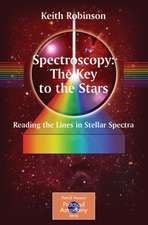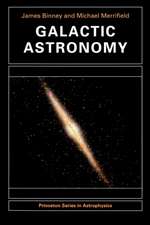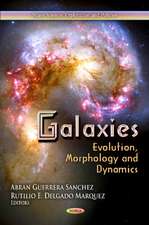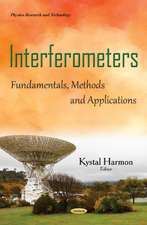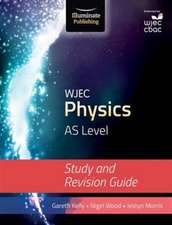Physics of Thermal Gaseous Nebulae: Physical Processes in Gaseous Nebulae: Astrophysics and Space Science Library, cartea 112
Autor L.H. Alleren Limba Engleză Paperback – 30 noi 1987
Din seria Astrophysics and Space Science Library
- 24%
 Preț: 799.10 lei
Preț: 799.10 lei - 15%
 Preț: 647.92 lei
Preț: 647.92 lei - 18%
 Preț: 983.81 lei
Preț: 983.81 lei - 18%
 Preț: 790.28 lei
Preț: 790.28 lei -
 Preț: 359.86 lei
Preț: 359.86 lei -
 Preț: 389.71 lei
Preț: 389.71 lei - 20%
 Preț: 691.14 lei
Preț: 691.14 lei - 20%
 Preț: 816.18 lei
Preț: 816.18 lei - 18%
 Preț: 1011.27 lei
Preț: 1011.27 lei -
 Preț: 402.56 lei
Preț: 402.56 lei - 15%
 Preț: 664.93 lei
Preț: 664.93 lei -
 Preț: 398.15 lei
Preț: 398.15 lei - 18%
 Preț: 954.77 lei
Preț: 954.77 lei -
 Preț: 411.04 lei
Preț: 411.04 lei - 18%
 Preț: 1225.31 lei
Preț: 1225.31 lei - 18%
 Preț: 1843.29 lei
Preț: 1843.29 lei -
 Preț: 393.13 lei
Preț: 393.13 lei -
 Preț: 400.26 lei
Preț: 400.26 lei - 18%
 Preț: 953.82 lei
Preț: 953.82 lei - 18%
 Preț: 960.61 lei
Preț: 960.61 lei -
 Preț: 398.35 lei
Preț: 398.35 lei -
 Preț: 390.84 lei
Preț: 390.84 lei -
 Preț: 413.76 lei
Preț: 413.76 lei -
 Preț: 416.64 lei
Preț: 416.64 lei -
 Preț: 404.51 lei
Preț: 404.51 lei - 18%
 Preț: 956.50 lei
Preț: 956.50 lei -
 Preț: 403.75 lei
Preț: 403.75 lei - 18%
 Preț: 1229.40 lei
Preț: 1229.40 lei - 18%
 Preț: 1224.99 lei
Preț: 1224.99 lei -
 Preț: 404.29 lei
Preț: 404.29 lei - 15%
 Preț: 654.77 lei
Preț: 654.77 lei - 18%
 Preț: 1248.20 lei
Preț: 1248.20 lei - 18%
 Preț: 955.25 lei
Preț: 955.25 lei - 18%
 Preț: 1846.28 lei
Preț: 1846.28 lei - 18%
 Preț: 1233.06 lei
Preț: 1233.06 lei - 18%
 Preț: 1234.77 lei
Preț: 1234.77 lei
Preț: 947.67 lei
Preț vechi: 1155.69 lei
-18% Nou
Puncte Express: 1422
Preț estimativ în valută:
181.39€ • 197.10$ • 152.47£
181.39€ • 197.10$ • 152.47£
Carte tipărită la comandă
Livrare economică 21 aprilie-05 mai
Preluare comenzi: 021 569.72.76
Specificații
ISBN-13: 9789027725462
ISBN-10: 9027725462
Pagini: 364
Ilustrații: 350 p.
Dimensiuni: 155 x 235 x 19 mm
Greutate: 0.51 kg
Ediția:Softcover reprint of the original 1st ed. 1984
Editura: SPRINGER NETHERLANDS
Colecția Springer
Seria Astrophysics and Space Science Library
Locul publicării:Dordrecht, Netherlands
ISBN-10: 9027725462
Pagini: 364
Ilustrații: 350 p.
Dimensiuni: 155 x 235 x 19 mm
Greutate: 0.51 kg
Ediția:Softcover reprint of the original 1st ed. 1984
Editura: SPRINGER NETHERLANDS
Colecția Springer
Seria Astrophysics and Space Science Library
Locul publicării:Dordrecht, Netherlands
Public țintă
ResearchCuprins
Preface.- 1: Types of Gaseous Nebulae.- Examples of Gaseous Nebulae.- HII Regions or Diffuse Nebulae.- Planetary Nebulae.- Supernova Remnants.- The 30 Doradus Nebular Complex.- Nonspatially Resolvable Objects, Galaxies and Stars.- Combination Variables and Other Exotic Objects.- A Concise List of References.- List of Illustrations.- 2: Spectra of Gaseous Nebulae.- 2A. The Primary Mechanism.- 2B. Collisionally-Excited Lines.- 2C. Permitted Lines in the Optical Region.- Some Suggested References.- List of Illustrations.- 3: Radiative Excitation, Ionization, Recombination, and Fluorescence.- 3A. Basic Relationships.- 3B. The Strömgren Sphere.- 3C. Free-Free Emission and BrehmsStrahlung.- 3D. Ionization Equation for Complex Atoms.- 3E. Dielectronic Recombination.- 3F. Collisional Ionization.- 3G. Charge Exchange.- 3H. Stellar Far Ultraviolet Radiation Fields.- 31. Line Excitation.- Problems.- Selected Bibliography.- List of Illustrations.- 4: Line and Continuous Spectra of Hydrogen and Helium.- 4A. Statistical Equilibrium, the Elementary Theory of the Balmer Decrement.- 4B. Improved Balmer Decrement Theory.- 4C. The Observed Balmer Decrement.- 4D. The Line and Continuous Spectrum of Hydrogen in the Radio-Frequency Region.- 4E. The Optical Continuum.- 4F. Hydrogen Plasmas at Moderately High Densities and Optical Thicknesses.- Problems.- References.- List of Illustrations.- 5: Collisionally Excited Lines and Plasma Diagnostics.- 5A (i). Collisional Excitation of Hydrogen Lines.- 5A (ii). Collisional Excitation of Lines of Heavier Elements.- 5A (iii). Transition Probabilities for Magnetic Dipole and Electric Quadrupole Transitions; a Quantum Mechanical Digression.- 5B (i). General Principles.- 5B (ii). Comments on Calculation of Collision Strengths.- 5C (i). “Low Density”Domain for p2 and p4 Configurations.- 5D (i). Collisionally-Excited Lines in the Near-Ultraviolet Region.- 5D (ii). Infrared Transitions.- 5D (iii). Ionic Concentrations for p3 Configurations.- 5E (i). Collisionally-Excited Lines as Tools for Plasma Diagnostics; Electron Temperatures.- 5E (ii). Collisionally-Excited Lines as Tools for Nebular Diagnostics; Electron Densities.- 5E (iii). Line Ratios That Depend on Both Temperature and Density.- 5F. Observational Checks on Accuracy of Theoretical Parameters.- Problems.- References.- List of Illustrations.- 6: Radiative Equilibrium of a Gaseous Nebula.- 6A. The Energy Balance of a Gaseous Nebula.- 6B. Persistence of a Maxwellian Velocity Distribution in a Photoionized Nebula.- Problem.- References.- List of Illustrations.- 7: Nebular Models.- 7A. Initial Assumptions.- 7B. Computational Procedures.- 7C. Dependence of Models on Input Parameters.- 7D. Some Complicating and Troublesome Factors for Nebular Model Constructions.- 7E. Time-Dependent Models.- 7F. Resonance Transitions and Transfer Problems.- 7G. Non-Radiative Excitation.- Problems.- References.- List of Illustrations.- 8: Dust and Related Phenomena in Gaseous Nebulae.- 8A. Extinction Effects Produced by Dust.- 8B. Dust and Infrared Spectra of Gaseous Nebulae.- 8C. Temperature and Energy Balance of the Dust.- 8D. Optical and Near UV Observations of Diffuse Nebulae.- 8E. Further Properties of Interstellar Dust Grains.- (1) Dust/Gas Ratio.- (2) Depletion of Refractory Elements in the Interstellar Medium.- (3) Linear Polarization.- (4) Variation of the Ratio R = AV/E(B-V).- (5) Are the Interstellar Media of Other Galaxies Similar to those of Our Own?.- References.- List of Illustrations.- 9: Shock Waves.- 9A. Introduction.- 9B. The Structure of Shocks.- 9C. Intricaciesand Complexities of Some Astrophysical Shock Phenomena.- 9D. Post-Shock Cooling Processes.- 9E. Radiative Transfer Effects.- 9F. Collisionless and Nonradiative Shocks.- 9G. Theoretical Models for Shock-Excited Nebulae.- 9H. Interpretation of Optical Spectra.- Problem.- References.- List of Illustrations.- 10: Diffuse Nebulae, Wind-Blown Shells and Planetaries.- 10A. Introduction.- 10B. Some Brief Comments on Molecular Clouds.- 10C. Relations Between H II Regions and Exciting Stars.- 10C1. Some Basic Considerations.- 10C2. The Orion Nebula.- 10C3. Sharpless 155 and a Nearby Cepheus Association.- 10D. Wind-Driven Shells and the Interstellar Medium.- 10D1. Some Theoretical Considerations.- 10D2. The Gum Nebula.- 10D3. 30 Doradus and NGC 604.- 10E. Planetary Nebulae.- 10E1. The Problem of Distances.- 10E2. Some Statistics of Planetary Nebulae.- 10E3. Structures and Internal Motions of Planetary Nebulae.- 10F. Bipolar Nebulae: Transition Objects or Young Planetaries.- References.- List of Illustrations.- 11: Chemical Compositions of Gaseous Nebulae.- 11A. Introduction.- 11B. Observational and Theoretical Problems of Composition Determination: Diffuse Nebulae.- 11C. Problems of Chemical Composition Determinations: Planetary Nebulae.- 11D. Examples of Abundance Determinations.- 11E. Compositions of Planetary Nebulae.- 11F. Planetary Nebular Compositions and Galactic Structure.- 11G. Abundance Determinations in H II Regions and Composition Gradients in Galaxies.- 11H. Abundance Gradients in the Disk of Our Galaxy.- References.- List of Illustrations.- 12: Nebular Compositions, Element Building, and Stellar Evolution.- 12A. Stellar Winds.- 12B. Late Stages of Stellar Evolution for Objects of Low-to-Intermediate Mass.- 12C. Origin of Planetary Nebulae; Some Theoretical Insightsand Observational Clues.- 12D. Carbon Stars and Their Relationship to Planetary Nebulae.- 12E. Comparison of Theory and Observations.- 12F. Notes on the Evolution of Very Massive Stars.- 12G. The Role of the Wolf-Rayet Stars.- 12H. Supernovae.- 12I. Principal Sources of Enrichment to the H II Regions.- 12J. H II Regions and the Chemical Evolution of Galaxies.- References.- List of Illustrations.- Appendix: Compilation of Transition Probabilities, Electron Excitation Rate Coefficients and Photoionization Cross sections.- 1. Indices.- 2. Methods.- 3. Accuracy.- 4. Transition Probabilities and Excitation Rate Coefficients.- References.- References to Individual Nebulae.- Index of Principal Symbols Used.
Recenzii
`...Professor Aller has done the astronomical community a great service in writing this thoroughly excellent and interesting book. It is a mine of information and its a pleasure to read. It will undoubtedly become a classic book and is required reading for anyone who considers themselves to be an astrophysicist. I have rarely read a book I can commend so highly.'
Astrophysics and Space Science (1985)
Astrophysics and Space Science (1985)

